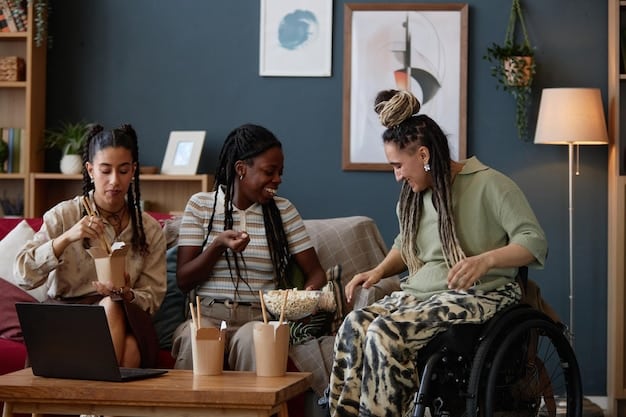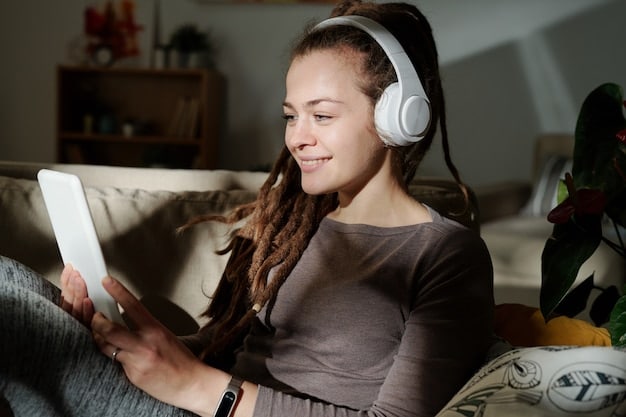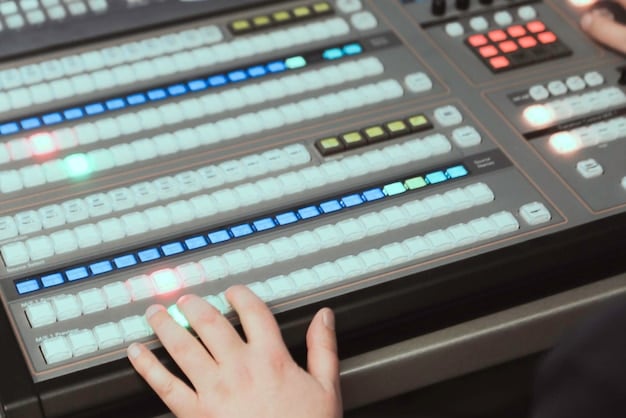Streaming Accessibility: Features and Options for Users with Disabilities in Brazil

Providing robust streaming accessibility features for users with disabilities in Brazil facilitates inclusive digital entertainment and ensures equitable access to a diverse range of content platforms that comply with evolving regulatory standards.
In an increasingly digital world, the ability to access entertainment is paramount, and for users with disabilities in Brazil, Streaming Accessibility: Features and Options for Users with Disabilities in Brazil are becoming essential. This article explores the evolving landscape of accessible streaming, examining critical features and the commitment of platforms to inclusivity, ensuring that digital content reaches every viewer.
The Imperative for Accessible Streaming in Brazil
The digital revolution has transformed how we consume media, with streaming services leading the charge. In Brazil, a nation with a significant population of people with disabilities, ensuring equal access to these platforms is not just a matter of social good but a fundamental right. The evolution of streaming technology must go hand-in-hand with an unwavering commitment to inclusivity, moving beyond basic compliance to true user empowerment.
Accessibility in streaming involves a multifaceted approach, addressing various forms of disability, including visual, auditory, cognitive, and motor impairments. This broad scope requires platforms to develop a comprehensive suite of features that cater to the diverse needs of their users. From subtitling to audio descriptions and intuitive navigation, each element plays a crucial role in creating an equitable viewing experience.
Understanding the Brazilian Context
Brazil has made significant strides in legislation promoting the rights of people with disabilities, such as the Brazilian Inclusion Law (Law No. 13.146/2015). This legal framework underscores the importance of accessibility across all sectors, including digital services. Streaming providers operating in Brazil are therefore compelled not only by global best practices but also by domestic legal obligations to prioritize accessibility.
- Legal Framework: Brazil’s Inclusion Law mandates equal opportunities and access for people with disabilities, influencing digital content provision.
- Market Size: A large demographic of users with disabilities represents a significant market segment that demands accessible solutions.
- Social Inclusion: Beyond legal requirements, accessible streaming fosters social inclusion, allowing everyone to participate in cultural and entertainment experiences.
The commitment to accessible streaming also extends to the content itself. It’s not enough to merely have technical features; the content must be created with accessibility in mind from the outset. This includes clear audio, distinct visual elements, and narratives that are inherently understandable when relying on accessibility aids. The journey towards fully accessible streaming is continuous, requiring ongoing innovation and adaptation to meet the evolving demands and technological advancements.
Core Accessibility Features for Streaming Platforms
For streaming services to be truly inclusive, they must incorporate a range of features designed to bridge the gap for users with disabilities. These features transform a passive viewing experience into an actively engaging one for everyone, regardless of their sensory or physical capabilities. The foundation of accessible streaming lies in these robust functionalities.
Closed Captions and Subtitles
Closed captions and subtitles are perhaps the most widely recognized accessibility features. While often used interchangeably, closed captions provide not only dialogue but also descriptions of non-speech elements like sound effects, music, and speaker identification, making them invaluable for individuals who are deaf or hard of hearing. Subtitles primarily translate dialogue and are often used by those watching content in a foreign language or learning a new language.
- For the Deaf and Hard of Hearing: Closed captions offer a complete textual representation of audio, including environmental sounds.
- Language Learning: Subtitles aid in language acquisition and understanding diverse accents.
- Noisy Environments: Both captions and subtitles enable viewing in situations where audio is difficult to hear.
The quality of captions and subtitles is paramount. They should be accurate, synchronized with the video, and appear in a legible font and size. Many platforms now offer customization options for text size, color, and background, allowing users to tailor the visual presentation to their preferences and specific needs. This level of customization significantly enhances the user experience.
Audio Descriptions
Audio descriptions provide narration of visual content for individuals who are blind or have low vision. This narration fills in the gaps between dialogue, describing actions, settings, character expressions, costumes, and on-screen text. It transforms a visual experience into an auditory one, enabling a richer understanding of the narrative and visual cues that would otherwise be missed.

The effectiveness of audio descriptions lies in their ability to convey essential visual information concisely and without interrupting the flow of the original audio. Professional narrators and scriptwriters are crucial for ensuring that these descriptions are well-timed, natural-sounding, and provide a comprehensive picture of what’s happening on screen. Expanding the availability of audio descriptions across various genres is a key area of focus for streaming services aiming for full accessibility.
User Interfaces and Navigation for All
Accessibility extends beyond content features; it encompasses the entire user experience, starting with the platform’s interface. An accessible user interface (UI) ensures that individuals with diverse abilities can navigate content, manage settings, and interact with the service effortlessly. A well-designed UI considers various input methods and sensory perception differences.
Keyboard Navigation and Screen Readers
For users with motor impairments or those who are blind or have low vision, keyboard navigation is often the primary method of interacting with digital content. An accessible interface must allow users to control all functions—from browsing titles to playing content and adjusting settings—using only a keyboard or alternative input devices that emulate keyboard commands. This means ensuring proper tab order, clear focus indicators, and accessible controls.
Screen readers, software that vocalizes on-screen text and elements, are indispensable for users who are blind or have severe low vision. A truly accessible UI is designed to be compatible with screen reader technologies, providing meaningful labels, descriptions, and structural information for every interactive element. This allows screen reader users to understand the context and purpose of buttons, menus, and content cards, facilitating independent navigation.
Key considerations for screen reader compatibility include:
- Semantic HTML: Using proper HTML tags (e.g.,
<button>,<nav>) provides inherent meaning for screen readers. - ARIA Attributes: Accessible Rich Internet Applications (ARIA) attributes offer additional semantic information for dynamic content and custom UI components.
- Clear Labels: All interactive elements should have descriptive and concise labels accessible to screen readers, avoiding generic terms like “click here.”
Customization Options and Visual Enhancements
Visual accessibility features within the user interface play a crucial role for individuals with low vision, color blindness, or cognitive disabilities. Offering extensive customization options for text size, contrast ratios, and color palettes allows users to tailor the display to their specific visual needs.
For instance, some users may benefit from high-contrast modes, where text and background colors are chosen to maximize readability. Others might require larger font sizes or the ability to disable distracting animations. The goal is to provide enough flexibility so that users can optimize their viewing environment, reducing eye strain and improving comprehension.
Moreover, intuitive design principles, such as consistent navigation patterns, clear iconography, and logical content organization, benefit all users, including those with cognitive disabilities. Minimizing complexity and providing clear feedback for user actions contributes to a more accessible and enjoyable experience for everyone.
Brazilian Streaming Platforms and Their Accessibility Efforts
In Brazil, a growing number of streaming platforms are enhancing their accessibility features, driven by both regulatory compliance and a commitment to broader audience reach. While progress is ongoing, several major players are making notable efforts to provide a more inclusive viewing experience.
Global Players and Local Adaptations
International streaming giants operating in Brazil, such as Netflix, Amazon Prime Video, and Disney+, generally lead the way in incorporating comprehensive accessibility features due to their global standards. These platforms offer a wide array of options, including:
- Netflix: Known for its extensive catalog of titles with closed captions, subtitles, and audio descriptions in multiple languages, including Portuguese. Netflix also invests in accessibility for its user interface and offers adaptive stream quality for varying internet speeds, which can also indirectly benefit some users.
- Amazon Prime Video: Provides subtitles and audio descriptions for a significant portion of its content. Their interface is also designed with accessibility in mind, supporting screen readers and keyboard navigation.
- Disney+: Offers similar features, with a strong emphasis on family-friendly content accessibility. It includes closed captions, subtitles, and audio descriptions for its vast library of movies and shows.
These platforms often adapt their offerings to the local Brazilian context, providing Brazilian Portuguese subtitles and audio descriptions where available. This localization is crucial for ensuring that accessibility features are truly effective for the target audience.
Brazilian-Owned Platforms and Emerging Trends
Brazilian streaming services, such as Globoplay and Looke, are also stepping up their accessibility game. While some may be playing catch-up to their international counterparts, their focus on local content often means a more intuitive implementation of Brazilian Portuguese accessibility features from the ground up.
“Globoplay, for example, has been progressively increasing the number of titles available with closed captions and audio descriptions, recognizing the importance of reaching all segments of the Brazilian population. Their commitment reflects a growing awareness within the Brazilian media landscape that accessibility is not an add-on, but a core component of sustainable business models.”
Emerging trends in Brazil include the integration of Brazilian Sign Language (Libras) interpreters for live events and specific content, a highly valued feature for the deaf community. Some platforms are also exploring AI-driven solutions for automated captioning and audio description, though human review remains critical for accuracy and quality. The collaborative efforts between technology providers, content creators, and disability advocacy groups in Brazil are vital for pushing these innovations forward.
Challenges and Opportunities in Streaming Accessibility
Despite significant progress, the landscape of streaming accessibility in Brazil still presents various challenges, alongside immense opportunities for further innovation and inclusion. Addressing these hurdles requires a concerted effort from all stakeholders: platforms, content creators, regulators, and users themselves.
Technical and Financial Hurdles
Implementing comprehensive accessibility features is not without technical complexities and financial implications. The process of creating high-quality closed captions, audio descriptions, and sign language interpretations is labor-intensive and requires specialized expertise and technology. For smaller streaming platforms or independent content creators, these costs can be prohibitive.

Moreover, ensuring compatibility across a myriad of devices and operating systems adds another layer of complexity. Mobile devices, smart TVs, gaming consoles, and web browsers all have different technical specifications, requiring platforms to develop robust and adaptable solutions that work seamlessly across various ecosystems. This fragmentation can make universal implementation a significant technical challenge.
Opportunities arise from these challenges through technological advancements. AI and machine learning are increasingly being employed to automate aspects of captioning and audio description, potentially reducing costs and increasing efficiency. However, human oversight remains critical to ensure accuracy and nuance, especially for complex narratives or specific cultural contexts. Funding partnerships and government incentives could also help smaller content producers overcome financial barriers to accessibility.
Content Diversity and Localization
While global platforms bring extensive accessibility features, a significant challenge lies in ensuring a diverse range of content, particularly local Brazilian productions, are equally accessible. Older content that predates modern accessibility standards often lacks captions or audio descriptions, requiring retroactive effort to make them available.
Localization is another critical opportunity. Beyond simply translating text, true localization involves adapting accessibility features to cultural nuances and specific communication methods, such as distinct regional sign languages. Providing Libras interpretation for Brazilian content is a powerful example of this, going beyond mere translation to meet the specific needs of the local deaf community.
Addressing these challenges presents opportunities for collaborative innovation. Partnerships between streaming services, production houses, and disability organizations can lead to the development of best practices and shared resources for creating accessible content from the outset. Furthermore, public awareness campaigns can highlight the importance of accessibility, increasing demand for inclusive content and incentivizing creators to prioritize these features.
The Future of Streaming Accessibility in Brazil
The trajectory of streaming accessibility in Brazil is promising, driven by technological innovations, evolving legislation, and increased user advocacy. The future points towards a more integrated, personalized, and universally accessible entertainment ecosystem, significantly impacting the lives of millions.
Advancements in AI and Machine Learning
Artificial intelligence and machine learning are poised to revolutionize accessibility features. Automated captioning and audio description generation will become more sophisticated, accurate, and cost-effective. While human review will likely remain essential for high-quality output, AI can significantly speed up the initial processing, making a broader range of content accessible more quickly.
Imagine real-time translation of sign language into text or speech, or AI-powered algorithms that can dynamically adjust visual elements for users with specific visual impairments. These advancements hold the potential to make accessibility an inherent part of content creation, rather than an afterthought, allowing for rapid deployment across vast content libraries. Predictive AI could even anticipate user needs, offering personalized accessibility settings based on past behavior and declared preferences.
Personalization and User Empowerment
The next frontier in streaming accessibility will likely focus on hyper-personalization. Users will have even greater control over how content is presented, allowing for custom configurations that go beyond simple text size or contrast adjustments. This might include:
- Adaptive Interfaces: UIs that automatically adjust layout and navigation based on a user’s known accessibility needs.
- Customizable Audio Tracks: The ability to adjust the volume of dialogue, background music, or sound effects independently.
- Personalized Audio Descriptions: Users selecting the detail level of audio descriptions, or choosing different voice actors.
Empowering users to tailor their streaming experience ensures that it genuinely meets their individual requirements, moving away from a one-size-fits-all approach. This level of customization fosters a sense of ownership and greatly enhances the overall enjoyment and utility of streaming services for individuals with disabilities.
Regulatory Evolution and Industry Standards
As technology progresses, so too will the regulatory landscape. Brazilian legislation will likely continue to evolve, setting higher standards for digital accessibility. This will push streaming platforms to innovate and adopt best practices more universally. Industry consortia and international bodies will also play a crucial role in developing global standards that promote interoperability and consistency across platforms.
The collective efforts of advocacy groups, technology developers, and government agencies will shape a future where accessible streaming is not just an option but the default. This ensures that everyone, regardless of their abilities, can fully participate in the rich and diverse world of digital entertainment. The ongoing dialogue and collaboration among these various stakeholders are vital for building a truly inclusive digital content environment in Brazil.
Ensuring Quality and User Experience in Accessibility
The mere presence of accessibility features is not enough; their quality and how they contribute to the overall user experience are paramount. Poorly implemented or unreliable features can be more frustrating than no features at all. Therefore, a continuous focus on refinement, user feedback, and best practices is essential for platforms striving for true inclusivity.
Beyond Compliance: A Focus on User-Centric Design
While regulatory compliance sets a baseline, leading streaming platforms understand that true accessibility goes beyond ticking boxes. It requires a user-centric design approach, where individuals with disabilities are involved throughout the development process. This means:
- User Testing: Engaging users with disabilities in testing new features and interfaces to identify pain points and improvements.
- Feedback Channels: Establishing clear and accessible channels for users to provide feedback on accessibility features.
- Empathy Mapping: Developing a deep understanding of diverse user needs and challenges to inform design decisions.
A user-centric approach ensures that features are not just functional but genuinely enhance the viewing experience. It moves accessibility from a technical requirement to an integral part of product development, fostering innovation that benefits all users.
Quality Control and Continuous Improvement
Maintaining high quality across all accessibility features is an ongoing commitment. This includes ensuring accuracy in captions and audio descriptions, consistency in interface navigation, and responsiveness across various devices. Quality control processes must be robust, incorporating both automated checks and human review.
For instance, automated captioning might provide speed, but human editors are crucial for correcting errors, adding context-specific sound cues, and ensuring synchronization. Similarly, audio descriptions require skilled narrators who can convey visual information effectively without disrupting the narrative flow. Investing in these quality assurance measures is an investment in the user experience.
Furthermore, the digital landscape is constantly evolving, with new technologies and user expectations emerging regularly. Streaming platforms must commit to continuous improvement, regularly updating their accessibility features, adopting new standards, and responding to emerging needs. This iterative process, driven by user feedback and technological advancements, is key to sustained accessibility leadership. Ultimately, the goal is to create a seamless, enjoyable, and equitable streaming experience for every single viewer in Brazil, making entertainment truly universal.
| Key Aspect | Brief Description |
|---|---|
| Captioning & AD 💬🎧 | Closed captions and audio descriptions are vital for hearing and visually impaired users. |
| UI Navigation ♿️⌨️ | Accessible interfaces support keyboard navigation and screen readers for diverse users. |
| Brazilian Context 🇧🇷⚖️ | Brazilian law and local platforms increasingly prioritize streaming accessibility. |
| Future Trends 💡🤖 | AI, personalization, and evolving regulations will shape future accessibility. |
Frequently Asked Questions About Streaming Accessibility
▼
Audio description is a narrative track that provides verbal descriptions of visual elements in a video, such as actions, settings, and character expressions, during pauses in dialogue. It’s crucial for users who are blind or have low vision, enabling them to understand and enjoy visual content that would otherwise be inaccessible.
▼
Brazilian streaming platforms must adhere to the Brazilian Inclusion Law (Law No. 13.146/2015), which mandates equal access for people with disabilities. This encourages the implementation of features like closed captions, audio descriptions, and accessible user interfaces. Compliance is an ongoing process, evolving with technological advancements and user needs.
▼
Many modern streaming services offer extensive customization options for accessibility features. Users can often adjust the font size, color, and background of captions, as well as control audio description playback. These personalization features are key to providing an optimized and comfortable viewing experience for diverse users.
▼
AI and machine learning are expected to play a significant role in automating and improving accessibility features. This includes more accurate automated captioning, AI-generated audio descriptions, and personalized adaptive interfaces. While human oversight remains vital, AI can help scale accessibility efforts across vast content libraries.
▼
Keyboard navigation is critical for users with motor impairments or those who rely on screen readers due to visual impairments. An accessible platform allows all functions—browsing, playback, settings—to be controlled entirely with a keyboard, ensuring independent interaction without needing a mouse.
Conclusion
The journey towards fully inclusive streaming in Brazil is a testament to the power of technology to connect and empower all individuals. As we’ve explored, the progress in providing robust accessibility features—from closed captions and audio descriptions to intuitive user interfaces—is not merely about compliance but about fostering genuine social inclusion. While challenges persist in technical implementation and content localization, the commitment of streaming platforms, coupled with advancements in AI and a growing emphasis on user-centric design, paints a promising future. Brazil is poised to lead the way in ensuring that the rich world of digital entertainment is truly accessible to everyone, regardless of their abilities, forging a more equitable and connected digital landscape.





